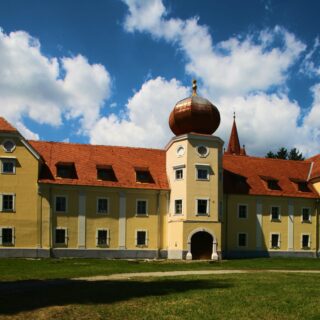Archaeological site of Rudina
The Rudina archaeological site is located on the slopes of Psunj, above the villages of Čečavac and Šnjegavić. More...

A living tradition and cultural monuments, an enchanting scenery of landscaped vineyards and the wild beauty of the natural park – the World of Graševina abounds in diverse contents among which everyone can truly find something for themselves and their soul.
The Rudina archaeological site is located on the slopes of Psunj, above the villages of Čečavac and Šnjegavić. More...
The cellar, whose foundation goes back to the 13th century, has been preserved in its original form, representing one of the main attractions of wine tourism. More...
This protected monument of architectural heritage was founded on the remains of a Cistercian abbey and it has been completely restored. More...
Villa Vinkomir was built according to the model of guardhouses from the times of the Ottoman Empire. More...
The Interpretation Centre Terra Panonica in Pleternica is meant to be a place where you can discover the wonderful world of natural beauty from the period of the Pannonian Sea until nowadays. More...
The library with a long history is dedicated to the preservation of the written word, culture and knowledge. More...
In the town of Pleternica, an educational trail has been arranged leading you through orchards and vineyards. More...
The unique wine route passes through a landscape full of vineyards alternating with plantations of multi-coloured roses. More...
The Požega County Palace is a building erected in historicist style, resulting from the extension of a Baroque building from the first half of the 18th century and which was remodeled for the needs of the county in 1745. More...
The Požega City Museum is a complex homeland museum with eight departments comprising more than 80 000 exhibits, books and publications. More...
This centre is meant to connect the town's cultural and tourist institutions and to be an ideal starting point for every guest. More...
The Požega city library is located in a protected cultural asset – the building of the First Požega Savings Bank. More...
The Sokol trail is an educational trail where you get acquainted with the natural resources of the Požega mountain, its plant and animal species, geological sights, vineyards and historical heritage. More...
This mountain south of Požega abounds in historical and sacred buildings. More...
Located in Trenkovo, this classicist castle and its adjoining park tell you the ancient story of this region through the legend of the famous baron Trenk and his "cops", their colourful experiences and adventures. More...
In the middle of the 18th century, the family of Counts Janković became the owners of the Pakrac manor, and with their actions they brought significant progress to the town. More...
Pakrac old town was one of the largest fortresses in Western Slavonia. More...
The Omanovac mountain hut is located on the Omanovac mountain slope above the Šeovice village, at 655 m/asl, on a clearing surrounded by coniferous forest. More...
The Pakrac City Museum is located within the Janković Little Castle, which is part of the Janković Manor House from the 18th century. More...
The sources of thermal healing water have been known since Roman times, but the first written documents about this healing centre date back to the 16th century when it was called the „Lipik spring“. More...
All horse lovers, and especially those of the famous Lipizzaner breed, must visit this stable, which is a living example of the tradition of horse breeding in this region. More...
In the heart of Kaptol settlement, there is a late Gothic-Renaissance fortress, an irregular hexagonal castle with round towers and half-towers. More...
The Kaptol archaeological site on the southern slopes of Papuk mountain witnesses life in these areas in the early Iron Age. More...
The Aquapark Shhhuma is located in Velika, in the heart of the Papuk Nature Park. More...